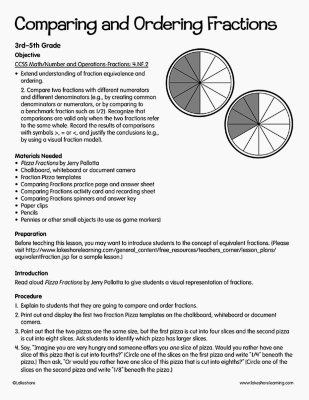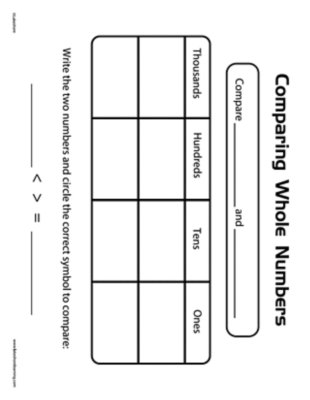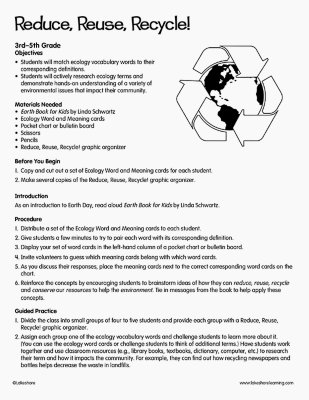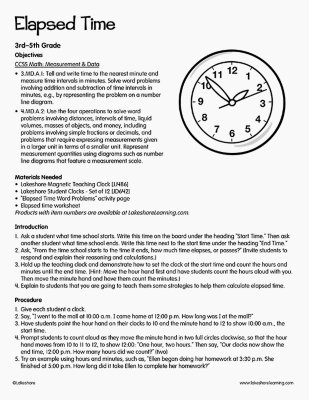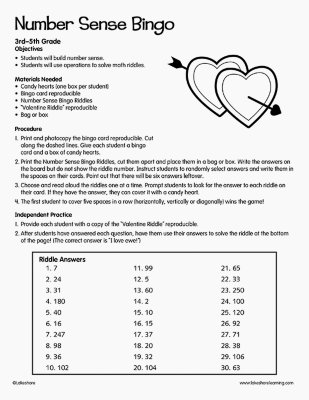Narrow by Grade
- Infant (0)
- Toddler (0)
- Preschool (0)
- Pre-K (0)
- Kindergarten (0)
- 1st (0)
- 2nd (0)
- 3rd (3)
- 4th (6)
- 5th (0)
- 6th & Up (0)
Grade
Narrow by Age
- 0-18m (1)
- 18-36m (5)
- 3 yrs. (0)
- 4 yrs. (5)
- 5 yrs. (8)
- 6 yrs. (8)
- 7 yrs. (9)
- 8 yrs. (7)
- 9 yrs. (6)
- 10 yrs. (3)
- 11 yrs. & Up (0)
Age 9 yrs.
6 results for "individual hands-on math kit"
Filters
Clear All
Menu Math
3rd Grade - 4th Grade
Objectives CCSS Math: Operations & Algebraic Thinking 3.OA.D.8: Solve two-step word problems using the four operations. Represent these problems using equations with a letter standing for the unknown quantity. Assess the reasonableness of answers using mental computation and estimation strategies including rounding. 4.OA.A.3: Solve multistep word problems posed with whole numbers and having whole-number answers using the four operations, including problems in which remainders must be
View Lesson PlanComparing and Ordering Fractions
4th Grade
Objective CCSS Math/Number and Operations-Fractions: 4.NF.2 Extend understanding of fraction equivalence and ordering. 2. Compare two fractions with different numerators and different denominators (e.g., by creating common denominators or numerators, or by comparing to a benchmark fraction such as 1/2). Recognize that comparisons are valid only when the two fractions refer to the same whole. Record the results of comparisons with symbols >, = or <, and justify the conclusions (e.g., by using a visual fraction model). Materials Needed Pizza Fractions by Jerry Pallotta Chalkboard, whiteboard or document camera Fraction Pizza templates Comparing Fractions practice page and answer sheet Comparing Fractions activity card and recording sheet Comparing Fractions spinners and answer key Paper clips Pencils Pennies or other small objects (to use as game markers) Preparation Before teaching this lesson, you may want to introduce students to the concept of equivalent fractions. (Please visit Equivalent Fraction Activities for a sample lesson.) Introduction Read aloud Pizza Fractions by Jerry Pallotta to give students a visual representation of fractions.
View Lesson PlanComparing Whole Numbers
4th Grade
Objective CCSS Math: Number & Operations in Base Ten 4.NBT.A.2: Read and write multi-digit whole numbers using base ten numerals, number names and expanded form. Compare two multi-digit numbers based on meanings of the digits in each place, using >, =, and < symbols to record the results of comparisons. Materials Needed Interactive whiteboard or chalkboard Large number cards Cardstock or Construction Paper - 9" x 12" (optional) Place value charts Preparation Make two sets of the number cards. (For durability, you may want to mount them onto sturdy construction paper or cardstock and laminate them.) Introduction Display the following symbols on an interactive whiteboard or chalkboard: > Invite students to discuss what each symbol means (greater than, less than and equal to). Remind students that these symbols are used when comparing two numbers to determine which is larger (greater than) or smaller (less than) or if they are equal.
View Lesson PlanReduce, Reuse, Recycle!
4th Grade
Objectives Students will match ecology vocabulary words to their corresponding definitions. Students will actively research ecology terms and demonstrate hands-on understanding of a variety of environmental issues that impact their community. Materials Needed Earth Book for Kids by Linda Schwartz Ecology Word and Meaning cards Pocket chart or bulletin board Scissors Pencils Reduce, Reuse, Recycle! graphic organizer Before You Begin Copy and cut out a set of Ecology Word and Meaning cards for each student. Make several copies of the Reduce, Reuse, Recycle! graphic organizer. Introduction As an introduction to Earth Day, read aloud Earth Book for Kids by Linda Schwartz.
View Lesson PlanElapsed Time
3rd Grade - 4th Grade
Objectives CCSS Math: Measurement & Data 3.MD.A.1: Tell and write time to the nearest minute and measure time intervals in minutes. Solve word problems involving addition and subtraction of time intervals in minutes, e.g., by representing the problem on a number line diagram. 4.MD.A.2: Use the four operations to solve word problems involving distances, intervals of time, liquid volumes, masses of objects, and money, including problems involving simple fractions or decimals, and problems that require expressing measurements given in a larger unit in terms of a smaller unit. Represent measurement quantities using diagrams such as number line diagrams that feature a measurement scale. Materials Needed Lakeshore Magnetic Teaching Clock Lakeshore Student Clocks - Set of 12 “Elapsed Time Word Problems” activity page Elapsed time worksheet Introduction Ask a student what time school starts. Write this time on the board under the heading “Start Time.” Then ask another student what time school ends. Write this time next to the start time under the heading “End Time.” Ask, “From the time school starts to the time it ends, how much time elapses, or passes?” (Invite students to respond and explain their reasoning and calculations.) Hold up the teaching clock and demonstrate how to set the clock at the start time and count the hours and minutes until the end time. (Hint: Move the hour hand first and have students count the hours aloud with you. Then move the minute hand and have them count the minutes.) Explain to students that you are going to teach them some strategies to help them calculate elapsed time.
View Lesson PlanNumber Sense Bingo
3rd Grade - 4th Grade
Objectives Students will build number sense. Students will use operations to solve math riddles. Materials Needed Candy hearts (one box per student) Bingo card reproducible Number Sense Bingo Riddles “Valentine Riddle” reproducible Bag or box
View Lesson Plan
